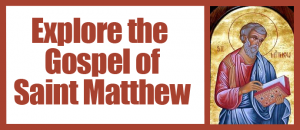 In Matthew’s Gospel, Jesus restricts His mission during His lifetime to Jews. When He gives His disciples mission instructions, He tells them: Go nowhere among the Gentiles, and enter no town of the Samaritans, but go rather to the lost sheep of the house of Israel. Later he says about Himself: I was sent only to the lost sheep of the house of Israel. It is only the risen Jesus, the post-Easter Jesus, in the last verse of the gospel, who commissions His followers to go to the nations, that is the Gentiles.
In Matthew’s Gospel, Jesus restricts His mission during His lifetime to Jews. When He gives His disciples mission instructions, He tells them: Go nowhere among the Gentiles, and enter no town of the Samaritans, but go rather to the lost sheep of the house of Israel. Later he says about Himself: I was sent only to the lost sheep of the house of Israel. It is only the risen Jesus, the post-Easter Jesus, in the last verse of the gospel, who commissions His followers to go to the nations, that is the Gentiles.
This being said, it is good to note that Matthew seems to be deeply hostile toward Jews – meaning those who opposed Jesus or at least did not respond to Him. Of course, the other gospels also report conflict between Jesus and some of His Jewish contemporaries, including groups like scribes, lawyers, Pharisees, Sadducees and temple authorities. But Matthew intensifies it. His language is harsher and more intemperate, vindictive, condemnatory and filled with invective. Along with John, Matthew has been for many centuries the major scriptural justification for Christian anti-Semitism and often deadly persecution of Jews.
The sharpness of Matthew’s hostility is seen in small details and in larger ways. In a detail involving pronouns, Matthew three times refers to their synagogues (4:23; 12:9; 13:54), as if Jews in synagogues were already other.
The hostility dominates a whole chapter in Matthew’s story of Jesus’ final week in Jerusalem. Matthew 23 (why not look it up) added to the story of Jesus’ last week as told by Mark, is a sustained indictment of the scribes and Pharisees. Scribes were a highly skilled, literate class who could read and write complex religious and legal documents. Most worked for the powerful and wealthy elite. Pharisees, by the time Matthew wrote in the late first century, were in the process of becoming the dominant interpreters of Judaism since by that time the temple and authorities no longer existed.
Though some of the content of Matthew’s indictment of scribes and Pharisees is also found in Luke (thus taken from the “Q” manuscript), Matthew’s language is stridently condemnatory and includes name-calling. They are not just hypocrites, but children of hell, blind guides, blind fools. They are whitewashed tombs that look great outside but are filled with rot and death inside. They are snakes, a brood of vipers, and descendants of those who murdered the prophets. The chapter then ends with a passage proclaiming the coming destruction of Jerusalem and the temple. Matthew interprets the destruction of the temple and Jerusalem in 70 CE by the Romans as God’s judgment on those who rejected Jesus. As you can see, the context of what was written is important to know!
